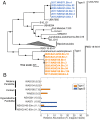Deep-branching acetogens in serpentinized subsurface fluids of Oman
- PMID: 36215489
- PMCID: PMC9586279
- DOI: 10.1073/pnas.2206845119
Deep-branching acetogens in serpentinized subsurface fluids of Oman
Abstract
Little is known of acetogens in contemporary serpentinizing systems, despite widely supported theories that serpentinite-hosted environments supported the first life on Earth via acetogenesis. To address this knowledge gap, genome-resolved metagenomics was applied to subsurface fracture water communities from an area of active serpentinization in the Samail Ophiolite, Sultanate of Oman. Two deeply branching putative bacterial acetogen types were identified in the communities belonging to the Acetothermia (hereafter, types I and II) that exhibited distinct distributions among waters with lower and higher water-rock reaction (i.e., serpentinization influence), respectively. Metabolic reconstructions revealed contrasting core metabolic pathways of type I and II Acetothermia, including in acetogenic pathway components (e.g., bacterial- vs. archaeal-like carbon monoxide dehydrogenases [CODH], respectively), hydrogen use to drive acetogenesis, and chemiosmotic potential generation via respiratory (type I) or canonical acetogen ferredoxin-based complexes (type II). Notably, type II Acetothermia metabolic pathways allow for use of serpentinization-derived substrates and implicate them as key primary producers in contemporary hyperalkaline serpentinite environments. Phylogenomic analyses indicate that 1) archaeal-like CODH of the type II genomes and those of other serpentinite-associated Bacteria derive from a deeply rooted horizontal transfer or origin among archaeal methanogens and 2) Acetothermia are among the earliest evolving bacterial lineages. The discovery of dominant and early-branching acetogens in subsurface waters of the largest near-surface serpentinite formation provides insight into the physiological traits that likely facilitated rock-supported life to flourish on a primitive Earth and possibly on other rocky planets undergoing serpentinization.
Keywords: Acetothermia; acetogenesis; metagenomics; origin of life; serpentinization.
Conflict of interest statement
The authors declare no competing interest.
Figures




Comment in
-
Narrowing gaps between Earth and life.Proc Natl Acad Sci U S A. 2022 Nov 16;119(46):e2216017119. doi: 10.1073/pnas.2216017119. Epub 2022 Oct 26. Proc Natl Acad Sci U S A. 2022. PMID: 36288265 Free PMC article. No abstract available.
References
-
- Russell M. J., Martin W., The rocky roots of the acetyl-CoA pathway. Trends Biochem. Sci. 29, 358–363 (2004). - PubMed
-
- McCollom T. M., Seewald J. S., Abiotic synthesis of organic compounds in deep-sea hydrothermal environments. Chem. Rev. 107, 382–401 (2007). - PubMed
-
- Seewald J. S., Zolotov M. Y., McCollom T. M., Experimental investigation of single carbon compounds under hydrothermal compounds. Geochim. Cosmochim. Acta 70, 446–460 (2006).
-
- Preiner M., et al. , A hydrogen-dependent geochemical analogue of primordial carbon and energy metabolism. Nat. Ecol. Evol. 4, 534–542 (2020). - PubMed
Publication types
MeSH terms
Substances
LinkOut - more resources
Full Text Sources
Miscellaneous

